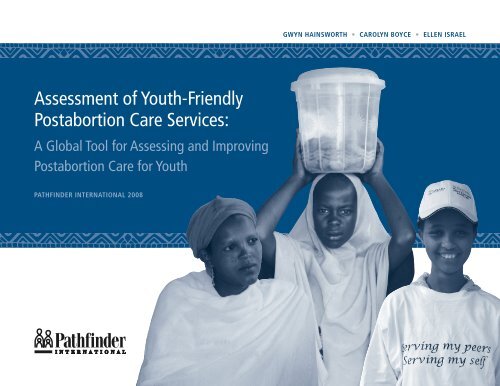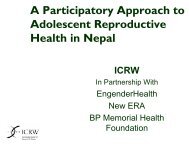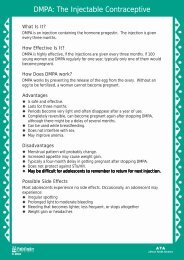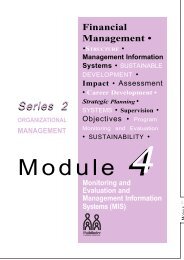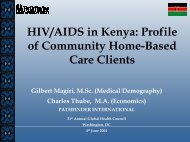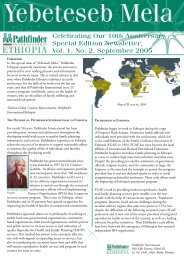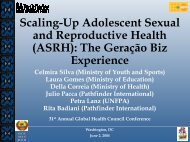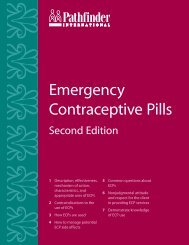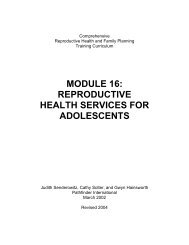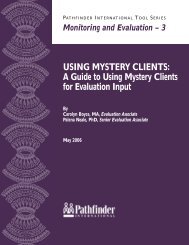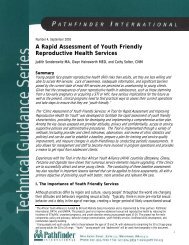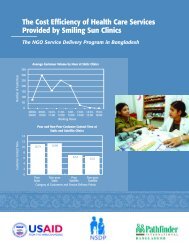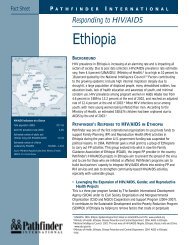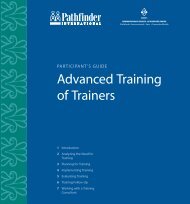Assessment of Youth-Friendly Postabortion Care Services:
Assessment of Youth-Friendly Postabortion Care Services:
Assessment of Youth-Friendly Postabortion Care Services:
- No tags were found...
You also want an ePaper? Increase the reach of your titles
YUMPU automatically turns print PDFs into web optimized ePapers that Google loves.
YOUTH-FRIENDLY POSTABORTION CARE (PAC) ASSESSMENT TOOLIntroductionThis tool is designed to help assessment teams, project managers, supervisors, and providers collect detailed information on the quality <strong>of</strong><strong>Postabortion</strong> <strong>Care</strong> (PAC) services provided to adolescents at a given facility in order to make services more youth-friendly. It can also be usedbefore PAC services have been established to see how best to design PAC services to meet youth’s needs. The assessment process facilitates thedevelopment <strong>of</strong> action plans for quality improvement that can help facilities address policy, operations, training, and other program areas needingadjustments and change. The tool also provides essential baseline information, allowing for repeated applications to measure changes and the impact<strong>of</strong> program interventions. Although the tool is primarily for use by a team, it may also be used by an individual.How to use the assessment toolASSEMBLING THE ASSESSMENT TEAM:The assessment team should consist <strong>of</strong> about four people, ideally a public health administrator working in reproductive health (i.e., MOH staff orNGO staff), a PAC service provider, a staff member <strong>of</strong> an organization implementing youth-friendly services/youth programs, and a youth withsome experience in reproductive health (e.g., a trained peer educator). Ideally facility staff should be involved as much as possible in theassessment process to encourage ownership. For example, facility staff can join the team when they examine the facility in terms <strong>of</strong> privacy,youth-friendly environment, or availability <strong>of</strong> IEC materials. They can also be instrumental in helping the team analyze service statistics andreview facility policies. The team leader should make sure that the tasks are clearly defined and that the team members have sufficient time tocarry out their responsibilities.ORGANIZATION OF THE ASSESSMENT GUIDE:This guide is organized according to the sections listed below:I. General Background InformationII. Client Volume and Range <strong>of</strong> <strong>Services</strong> ProvidedIII.PersonnelIV. Elements <strong>of</strong> <strong>Youth</strong>-<strong>Friendly</strong> PACAnnex A Observation <strong>of</strong> Equipment and Commodity StorageAnnex B Observation <strong>of</strong> Infection Prevention PracticesAnnex C Observation <strong>of</strong> Provider’s Clinical SkillsSection IV, Elements <strong>of</strong> <strong>Youth</strong>-<strong>Friendly</strong> PAC, is divided into several sections (see example below). There is a standard (e.g., respect for youthclient) followed by suggested data collection method(s) to be used (FA = interview facility administrator/manager, Y = interview youth client,SP= interview service provider, O = observe facility environment or observe client-provider interaction, and R = review policies, statistics, orprocedures), followed by potential questions to ask or suggestions on what to observe. To the right <strong>of</strong> this is a space to write the responses to thequestions followed by definitions <strong>of</strong> each score (0-2). To the right <strong>of</strong> this, is a place to note any additional comments or recommendations. It isPathfinder International • <strong>Assessment</strong> <strong>of</strong> <strong>Youth</strong>-<strong>Friendly</strong> <strong>Postabortion</strong> <strong>Care</strong> <strong>Services</strong> 1
important that assessors note any data that they collect in the response section. Only later will a specific score be assigned depending on thedegree to which the standard has been met (see bullet f below).4. Respect for youthclientSP, O, Y: Do providers show respectfor the adolescent PAC client duringtreatment, counseling, andconsultations? Do providers informclients that they don’t have toprovide information if it feels toosensitive? Do providers allow clientsto ask questions?Example: Providers said they treat youth with respect and allow them to ask questions.<strong>Youth</strong> clients/observation confirm that all clinic staff (receptionist, counselor,provider) treat the adolescent PAC client with respect and courtesy and allowclients time to ask questions.<strong>Youth</strong> clients/observation reveal that sometimes clinic staff do not treat youthwith respect and courtesy and allow clients time to ask questions OR staffreport they treat adolescents with respect, but this cannot be confirmed by clientinterviews or through observation.Clinic staff do not treat the adolescent PAC client with respect and courtesy andallow clients time to ask questions most <strong>of</strong> the time.210No youth clients werepresent so nointerviews orobservationsconducted.CARRYING OUT THE ASSESSMENT:The team should understand the nature <strong>of</strong> and time required for the assessment, which includes the following tasks:a. Arrangements must be made for the assessment visit. The assessment can take up to a full day, but a minimum <strong>of</strong> four hours. Besidesagreeing upon the date and time for the assessment, arrangements need to be made for all the interviews and observations.b. In advance, the team should familiarize itself with the elements to be assessed and discuss the definitions to make sure that all teammembers understand them. The team should also divide up the work. For example, two team members might be assigned to interviewthe facility administrator, while other team members interview youth clients. Take into account the routine <strong>of</strong> the service providers andtry to make data collection as unobtrusive as possible. Consider timing; which sections require clients, which sections can be completedwhen there are no clients? Be flexible; it may be impossible to complete the whole guide at one time. You may have to wait to observesome procedures.c. Before collecting the data, it is very important that the assessment team discuss the assessment objectives with facility staff andsupervisors. If possible, discuss this before the assessment, so all opportunities to observe PAC services can be utilized. The assessmentteam leader should explain clearly how and why the assessment will be done, emphasizing that the assessment guide is designed not t<strong>of</strong>ind fault, but to identify areas where improvements can be made.d. For each section, fill in the information requested. Use your judgment and ask other pertinent questions that may not be included in theassessment tool. Use the comments/recommendations column—these observations <strong>of</strong>ten provide very useful information.e. When the team has collected as much information as possible, the team should meet and make sure all information is recorded accuratelyand completely.Pathfinder International • <strong>Assessment</strong> <strong>of</strong> <strong>Youth</strong>-<strong>Friendly</strong> <strong>Postabortion</strong> <strong>Care</strong> <strong>Services</strong> 2
f. The group should reassemble, at a place on-site if possible, to compare notes and carry out the scoring process. If this task is done on-site,the team can go back for further questioning and observation to clarify issues or resolve conflicts if necessary. Each element has a possiblescore <strong>of</strong> 0-2 with 2 being the highest. Definitions <strong>of</strong> each score are provided under each element to help ensure consistency and reduce biasin scoring.Client Rights During Facility <strong>Assessment</strong>To ensure that the client’s rights are respected at all times during the assessment process, team members should review the rights <strong>of</strong> the client toprivacy and confidentiality. When a client is undergoing a physical examination, it should be carried out in an environment in which her right toprivacy is respected. When receiving counseling, undergoing a physical examination, or receiving contraceptive services, the client should beinformed about the role <strong>of</strong> each individual inside the room (e.g., service provider, assessment team members).The client’s permission must be obtained before having a member <strong>of</strong> the assessment team observe any services. The client should understand thatshe has the right to refuse being observed or interviewed. She also has the right to refuse to answer specific questions during the interview. Aclient’s care should not be rescheduled or denied if she does not permit a member <strong>of</strong> the assessment team to be present.Discussions among team members about specific client interviews or observations should always take place in a private area, out <strong>of</strong> listeningrange <strong>of</strong> other staff and clients, and should be conducted without reference to the client’s name.Adapted from: Sullivan, R., R. Magarick, G. Bergthold, A. Blouse, and N. McIntosh. 1995. Clinical training skills for reproductive health pr<strong>of</strong>essionals. Baltimore:JHPIEGO Corporation.SCORING:Each element in the tool should be scored according to the definitions provided. The individual element scores (i.e., 0-2) should be added togetherto determine a total score. The highest possible score (i.e., where all elements received a 2) would be 50. For other scores please see the categoriesbelow:42-50 PAC services are deemed to be youth-friendly and the overall quality is very high.34-41 PAC services are acceptable for young people but there is a need for improvement27-33 PAC services need significant improvement to meet the needs <strong>of</strong> adolescent clients
USING THE INFORMATION:After the assessment, lead facility staff in a discussion <strong>of</strong> the areas that show the greatest strengths and weaknesses. It is <strong>of</strong>ten a good idea to start withwhat the facility staff think are the strengths and weaknesses before sharing the assessment results.Prioritizing the Issues:After reviewing the assessment results with the facility staff, begin prioritizing issues. In most cases many issues will be identified. Address the mostcritical (e.g., infection prevention, privacy, postabortion contraception) first—the rest can be handled later. Using the action plan template on theinside back cover, note the issues that are most important.Selecting Solutions or Actions:For each issue, discuss the root cause and a solution or action that is feasible in terms <strong>of</strong> time, money, and authority. Solutions or actions mayinclude conducting refresher training or in-service updates, acquiring needed equipment or supplies, making small changes in infrastructure toincrease privacy, creation <strong>of</strong> posters and brochures, providing job aids, or getting the community/youth involved.In selecting the appropriate solution or action consider the following questions:• Will it be effective in improving the quality <strong>of</strong> services?• Is it feasible, affordable, and sustainable?• Are the systems in place to support it?• Will the facility manager or supervisor support it?For the action plan to be effective, staff must determine the root causes <strong>of</strong> each issue so that the solution can be valid. A solution based onsymptoms will be a short-term solution at best and will not solve the issue. In identifying responsible persons, encourage all staff to volunteer orassign tasks based on the staff person’s capability to accomplish them. Avoid assigning all issues to high-ranking staff. In assigning due dates, besure to agree on a due date that is realistic.Pathfinder International • <strong>Assessment</strong> <strong>of</strong> <strong>Youth</strong>-<strong>Friendly</strong> <strong>Postabortion</strong> <strong>Care</strong> <strong>Services</strong> 4
I. General Background InformationThis section is designed to provide general information about the facility, its size and location, as well as details <strong>of</strong> the certification process.Date <strong>of</strong> Visit: ______________________Name <strong>of</strong> Facility: ________________________________________________________________________________________________________Location: _____________________________________________________________________ Rural ______ Urban _______ Peri-urban_______Type <strong>of</strong> Facility: MOH/Gov’t ___________ NGO ____________ Other _______________Level <strong>of</strong> Facility: _____________________________________________ (e.g., Comprehensive Health Center, Primary Health Center)Number <strong>of</strong> Rooms: Total ________ Waiting Room ______ Examination Room ________ Separate PAC procedure room________Separate counseling space __________ Laboratory _______________ Other______________________________Staff Interviewed (Names and Position):Person(s) Conducting <strong>Assessment</strong> (Name and Affiliation):Pathfinder International • <strong>Assessment</strong> <strong>of</strong> <strong>Youth</strong>-<strong>Friendly</strong> <strong>Postabortion</strong> <strong>Care</strong> <strong>Services</strong> 5
II. Client Volume and Range <strong>of</strong> <strong>Services</strong> ProvidedUsing facility records, collect 3 months <strong>of</strong> data related to PAC. Record the total number <strong>of</strong> female clients (adults and youth) served in the firstcolumn. Divide the total by 3 and enter the monthly average in the second column. Record the total number <strong>of</strong> youth served, broken down by age.After each age group, enter the monthly average. If monthly statistics vary greatly, note this and any additional comments in the "Comments" box.Service ProvidedUterine Evacuation for PACManual Vacuum Aspiration (MVA)Dilation and Curettage (D&C)Electrical Vacuum Aspiration (EVA)Misoprostol for PAC<strong>Postabortion</strong> CounselingGeneral counseling<strong>Postabortion</strong> contraceptive counseling<strong>Postabortion</strong> ContraceptionOral Contraceptive PillsCondomsIUDInjectableImplantsEmergency Contraceptive Pills (ECP)Other <strong>Services</strong> (for PAC clients only)Treatment/counseling on gender-based violenceSexually Transmitted Infections (STI) and riskassessment counselingSTI testing and treatmentVoluntary Counseling and Testing/HIV test onlyAntiretroviral therapy (ART)Referral for other servicesNo. <strong>of</strong> All Clients No. <strong>of</strong> Young Female Clients ServedServed(youth and adult) (20-24) (15-19) (10-14)TotalMonthlyAvg.TotalMonthlyAvg.TotalMonthlyAvg.TotalMonthlyAvg.CommentsPathfinder International • <strong>Assessment</strong> <strong>of</strong> <strong>Youth</strong>-<strong>Friendly</strong> <strong>Postabortion</strong> <strong>Care</strong> <strong>Services</strong> 6
Write in the hours (e.g., 12-5 pm) for each day <strong>of</strong> the week that the following services are available to adolescent clients (observe the previousweek). In some instances, a particular service (e.g., postabortion contraception) may be <strong>of</strong>fered at different times than emergency treatment,which is <strong>of</strong>fered at all hours, so make sure to ask about each service individually.Schedule <strong>of</strong> Available <strong>Services</strong><strong>Services</strong> Offered Sunday Monday Tuesday Wednesday Thursday Friday SaturdayUterine evacuation: MVAUterine evacuation: D&CUterine evacuation: other(specify)<strong>Postabortion</strong> counseling<strong>Postabortion</strong> contraceptivecounseling<strong>Postabortion</strong> contraceptionTreatment and counseling onsexual abuse or violenceSTI testingVCT/HIV test onlySTI treatmentARTOther Reproductive Health(RH) servicesPathfinder International • <strong>Assessment</strong> <strong>of</strong> <strong>Youth</strong>-<strong>Friendly</strong> <strong>Postabortion</strong> <strong>Care</strong> <strong>Services</strong> 7
III. PersonnelThis section is for gathering information about the staff providing services at the facility and their level <strong>of</strong> training. In order to provide services <strong>of</strong>good quality, facilities must have staff who can cover all aspects <strong>of</strong> adolescent PAC.List all personnel involved in the provision <strong>of</strong> PAC services (including counseling and postabortion contraception) for adolescents and thetraining they have received, using the codes beneath the table. Common staff titles include manager, midwives, doctors, nurses, counselors,receptionist, and peer counselors; however some facilities or health systems may use different terms. Give whatever titles are used by the facilitystaff themselves.Name Sex Title Type <strong>of</strong> Training Training Agency and DatePathfinder International • <strong>Assessment</strong> <strong>of</strong> <strong>Youth</strong>-<strong>Friendly</strong> <strong>Postabortion</strong> <strong>Care</strong> <strong>Services</strong> 8
Name Sex Title Type <strong>of</strong> Training Training Agency and Date1 = PAC (MVA/EVA) 7 = Adolescent Reproductive Health/<strong>Youth</strong>-<strong>Friendly</strong> <strong>Services</strong>2 = PAC (D&C) 8 = Life Skills and Livelihood Training3 = PAC (misoprostol) 9 = General Reproductive Health4 = Contraception/Family Planning 10 = Safe abortion5 = Counseling 11 = Counseling/treatment for gender-based violence6 = Management <strong>of</strong> STIs 12 = Other (please note the type <strong>of</strong> training)P A T H F I N D E R I N T E R N A T I O N A L • C L I N I C A S S E S S M E N T O F Y O U T H F R I E N D L Y S E R V I C E S 5Pathfinder International • <strong>Assessment</strong> <strong>of</strong> <strong>Youth</strong>-<strong>Friendly</strong> <strong>Postabortion</strong> <strong>Care</strong> <strong>Services</strong> 9
IV. Elements <strong>of</strong> <strong>Youth</strong>-<strong>Friendly</strong> PACLegend: FA = Interview facility administrator/manager SP = Interview service providerY= Interview youth client O = Observation R = Review policies, procedures, and statisticsStandardsMethods/ QuestionsIndicatorsScore2, 1, 0Comments/RecommendationsOverall1. PAC services available 24hours, 7 days a weekWrite answers hereFA, Y, SP (Complete “Schedule <strong>of</strong>Available <strong>Services</strong>” page 7):Is treatment for complications <strong>of</strong>abortion available 24 hours a day, 7days a week? If so, what methods <strong>of</strong>treatment are available (MVA, EVA,D&C, misoprostol)? Are any <strong>of</strong> thesemethods only available at certaintimes? If so, which ones? Ispostabortion counseling <strong>of</strong>fered24/7? Is postabortion contraception<strong>of</strong>fered 24/7?Comprehensive PAC services (treatment, counseling, contraception, and 2referral for other services) are available 24 hours a day, 7 days a week.Treatment <strong>of</strong> complications <strong>of</strong> abortion is available 24/7, but counseling and 1contraception are not available 24/7.None <strong>of</strong> the services are <strong>of</strong>fered 24/7. 0Pathfinder International • <strong>Assessment</strong> <strong>of</strong> <strong>Youth</strong>-<strong>Friendly</strong> <strong>Postabortion</strong> <strong>Care</strong> <strong>Services</strong> 10
StandardsMethods/ Questions2. Privacy is ensuredIndicatorsScore2, 1, 0Comments/RecommendationsSP, O, Y: Does the PAC procedureroom <strong>of</strong>fer visual and auditoryprivacy? And the PAC counselingroom? Are there doors and are theyshut during consultation? Are therecurtains in the window? If windowsare left open, can anyone easily hearwhat is being said? Are screensused? Does personal history taking,screening, or asking why the clienthas come for services occur inpublic? Are there any nonessentialinterruptions during counseling,exams, or lab procedures?3. Confidentiality isensured<strong>Youth</strong> clients/observation confirm that visual and auditory privacy is ensured inconsultation (procedure, FP, and counseling) rooms with adequate enclosures.There are no nonessential interruptions or intrusions.Visual and auditory privacy is ensured most <strong>of</strong> the time in consultation roomswith adequate enclosures or there are limited nonessential interruptions orintrusions.Visual and auditory privacy are not ensured or there are many nonessentialinterruptions or intrusions.210FA, SP, Y, O, R: Does the facilityassure confidentiality throughout thePAC process? Is there a writtenpolicy on client confidentiality? Isregistration and record storage donein a manner that ensuresconfidentiality? Do youth feel theirpersonal information is keptconfidential?<strong>Youth</strong> clients confirm that the facility assures client confidentiality regardingboth the consultation(s) and medical records (storage and registration). Awritten policy exists outlining client confidentiality.The facility assures client confidentiality most <strong>of</strong> the time regarding either theconsultations or medical records (storage and registration). A written policymay or may not exist.The facility fails to assure client confidentially at least most <strong>of</strong> the time. Nowritten policy exists.210Pathfinder International • <strong>Assessment</strong> <strong>of</strong> <strong>Youth</strong>-<strong>Friendly</strong> <strong>Postabortion</strong> <strong>Care</strong> <strong>Services</strong> 11
StandardsMethods/ Questions4. Competent staffIndicatorsScore2, 1, 0Comments/RecommendationsSP, O, Y (Complete Section III:Personnel, p. 8 and use Annex C,p. 28 during observation):Did all staff members receivetraining on how to serve adolescentPAC clients? What type and for howlong? How well do staffcommunicate with youth? How welldo they serve youth?5. Non-medical stafforiented<strong>Youth</strong> clients/observation confirm that staff are able to communicate well withadolescents, explain their physical condition in clear terms, competentlydeliver PAC services, discuss contraceptive options (including dualprotection), and answer client questions.Staff are able to communicate well with adolescents, competently deliver PACservices, discuss contraceptive options (including dual protection), and answerclient questions some <strong>of</strong> the time.Staff are not able to communicate well with adolescents, competently deliverPAC services, discuss contraceptive options (including dual protection), oranswer client questions.210FA, O: Did all staff members receivean orientation about adolescent PACclients? What type and for howlong?All staff who provide supportive or auxiliary roles (such as receptionist,security guard, cleaner, etc.) were oriented to communicating with young PACclients in a friendly and respectful manner.Some staff who provide supportive or auxiliary roles were oriented tocommunicating with young PAC clients in a friendly and respectful manner.No staff who provide supportive or auxiliary roles were oriented tocommunicating with young PAC clients in a friendly and respectful manner.210Pathfinder International • <strong>Assessment</strong> <strong>of</strong> <strong>Youth</strong>-<strong>Friendly</strong> <strong>Postabortion</strong> <strong>Care</strong> <strong>Services</strong> 12
StandardsMethods/ Questions6. Respect for youthclientIndicatorsScore2, 1, 0Comments/RecommendationsSP, O, Y: Do providers show respectfor the adolescent PAC client duringtreatment, counseling, andconsultations? Do providers informclients that they don’t have toprovide information if it feels toosensitive? Do providers allow clientsto ask questions?7. Sufficient supply <strong>of</strong>appropriate equipment andsupplies<strong>Youth</strong> clients/observation confirm that all clinic staff (receptionist, counselor,provider) treat the adolescent PAC client with respect and courtesy and allowclients time to ask questions.<strong>Youth</strong> clients/observation reveal that sometimes clinic staff do not treat youthwith respect and courtesy and allow clients time to ask questions OR staffreport they treat adolescents with respect, but this cannot be confirmed by clientinterviews or through observation.Clinic staff do not treat the adolescent PAC client with respect and courtesy andallow clients time to ask questions most <strong>of</strong> the time.210FA, SP, O, Y (Complete Annex A,p. 23): Is there sufficient equipmentfor the provision <strong>of</strong> PAC services toadolescent clients? Are there PACor youth job aids available to helpservice providers in their daily work(i.e., flipchart, posters that remindthem <strong>of</strong> key messages, clients’ rights,etc.)?Clinic examination confirms that all appropriate equipment and supplies are 2available and working for youth-friendly PAC services.Most equipment and supplies are available and working. 1Many <strong>of</strong> the equipment and supplies necessary for youth-friendly PAC0services are not available.Pathfinder International • <strong>Assessment</strong> <strong>of</strong> <strong>Youth</strong>-<strong>Friendly</strong> <strong>Postabortion</strong> <strong>Care</strong> <strong>Services</strong> 13
StandardsMethods/ Questions10. Affordable FeesIndicatorsScore2, 1, 0Comments/RecommendationsFA, Y, R: How much are youthcharged for PAC services and specificcontraceptive methods? Are thesefees affordable for area youth?11. Adequate rooms/areas existto carry out PAC servicesFA, SP, O: Does the facility havethe following rooms/areas:• Separate room for the processing<strong>of</strong> equipment• Place for hand washing for staff• Place for medical waste disposal• Private procedure room fortreatment• Recovery area• LaboratoryAre these in good working order?12. Comfortable setting<strong>Youth</strong> clients confirm that the cost <strong>of</strong> all services is free to adolescents, or2affordable to most youth living in the nearby area.The cost <strong>of</strong> most services seems affordable to most youth but this cannot be 1confirmed through youth interviews.The cost <strong>of</strong> most services comprises a barrier to access for most youth. 0Observation confirms that all rooms/areas exist and are in good working order. 2All rooms/areas exist, but they may need slight improvements. 1Essential rooms/areas do not exist and/or need major improvements to get them 0in good working order.O, Y: Does the facility provide acomfortable setting for adolescentPAC clients? Is there a separatewaiting area for youth? Observe:• Cleanliness• Crowding/space<strong>Youth</strong> clients confirm that the facility environment includes items to make youthPAC clients feel at ease and comfortable (such as youth-oriented posters) andan environment that is clean and not overly crowded.2Pathfinder International • <strong>Assessment</strong> <strong>of</strong> <strong>Youth</strong>-<strong>Friendly</strong> <strong>Postabortion</strong> <strong>Care</strong> <strong>Services</strong> 15
StandardsMethods/ Questions• <strong>Youth</strong> posters on walls• Toilets13. Routine monitoring is usedto improve PAC servicesIndicatorsThe facility environment either includes some items to make youth PAC clientsfeel at ease and comfortable (such as youth-oriented posters) or has anenvironment that is clean or not overly crowded.The facility environment does not include items to make youth feel at ease andcomfortable, is not clean, and is overly crowded.Score2, 1, 010Comments/RecommendationsFA, SP, R: Are the following recordsaccurate and complete:• Informed consent• Medical history• Physical exam and treatment• Contraceptive method chosenand how many given• Notes on return visit• Referral• Maternal deathsAre service statistics collected andrecorded correctly (are statsdisaggregated by age)? Is there asystem for filing and retrieval <strong>of</strong>clients’ records? Is the collected datareviewed and analyzed? Are servicetrends reported back to key hospitalstaff? Are there mechanisms toreview maternal deaths andcomplicated cases?Observation confirms that records are accurately maintained and filed, andinterviews reveal that data is analyzed and used by key hospital staff.Records are accurately maintained and filed, but data may or may not beanalyzed and used by key hospital staff.Records are not accurately maintained or filed, and data are not analyzed norused by key hospital staff.210Pathfinder International • <strong>Assessment</strong> <strong>of</strong> <strong>Youth</strong>-<strong>Friendly</strong> <strong>Postabortion</strong> <strong>Care</strong> <strong>Services</strong> 16
StandardsMethods/ Questions14. Outreach servicesavailableIndicatorsCommunity and Provider PartnershipsScore2, 1, 0Comments/RecommendationsFA, Y: Are there staff or volunteers(e.g., peer educators) who dooutreach activities? If so, what type?Describe their duties (e.g., providenon-clinical methods, refer clientswho need PAC to the facility). Arethere ways clients can accessinformation or counseling <strong>of</strong>f site(hotline, website, mail)?Please describe.At least one youth-focused service is available by means outside <strong>of</strong> the facility 2itself, such as through peer educators or community-based health workers,community-based sites, such as recreational and social venues that are linkedand able to refer to the clinic, or through hotlines, a website, or mail.At least one service is available by means outside <strong>of</strong> the facility itself, such as 1through peer educators and community-based health workers, or throughcommunity-based sites, such as recreational and social venues that are linkedand able to refer to the clinic. However, this service is not specifically for youth(e.g., a facility nurse does general outreach to the community, but the effort isnot focused on youth), but for the larger community.No services are available outside <strong>of</strong> the facility. 015. Community and youth areaware <strong>of</strong> PAC services andwhere youth can accesscontraceptive servicesFA, O, Y: Is the community andyouth aware <strong>of</strong> the existence <strong>of</strong> PACservices? Are youth aware <strong>of</strong>available contraceptive services? Isthere a sign at the front <strong>of</strong> the facilitylisting services and clinic workinghours? Does publicity about theclinic identify services <strong>of</strong>fered andstress confidentiality? What otherways are services publicized?The facility effectively makes its services and times <strong>of</strong> operation known to the youthpopulation in the community through outreach, media, signboard, and otherchannels.The facility makes its services known to the youth population in thecommunity through at least one <strong>of</strong> the above channels.The facility does not publicize its services to the youth population in thecommunity.210Pathfinder International • <strong>Assessment</strong> <strong>of</strong> <strong>Youth</strong>-<strong>Friendly</strong> <strong>Postabortion</strong> <strong>Care</strong> <strong>Services</strong> 17
StandardsMethods/ QuestionsIndicatorsCounselingScore2, 1, 0Comments/Recommendations16. Counseling includescomprehensive informationSP, O, Y: Does the provider giveclear and simple information on whatto expect during physical exam,treatment, and any otherprocedures? Does the providerexplain the patient’s condition so shecan understand? Does the provideruse visual aids during counseling?Does the provider encourage theyouth client to talk about her feelingsregarding the abortion? Does theprovider explain the immediatereturn <strong>of</strong> fertility (and if the clientwishes, how long to wait beforebecoming pregnant again)?Does the provider screen forSTIs/HIV and help the client assessher risk <strong>of</strong> STIs/HIV? Does theprovider give clear instructions onany follow-up care, including anyneeded medications, and discusspost-treatment danger signs andsymptoms that would require theclient to immediately return to thefacility?<strong>Youth</strong> clients/observation confirm that providers include clear comprehensiveinformation (e.g., what to expect during procedures, how to avoid anotherunintended pregnancy or how long to wait before trying to become pregnantagain, risk assessment for STI/HIV, and any needed follow-up care) duringcounseling sessions.Providers give clear comprehensive information (see above for topics) to theclient most <strong>of</strong> the time during counseling sessions OR providers report theyprovide full information but this cannot be confirmed through client interviews orobservation.Providers rarely give clear comprehensive information to the client duringcounseling sessions.210Pathfinder International • <strong>Assessment</strong> <strong>of</strong> <strong>Youth</strong>-<strong>Friendly</strong> <strong>Postabortion</strong> <strong>Care</strong> <strong>Services</strong> 18
StandardsMethods/ Questions17. Emphasis on dualprotection/ condomsIndicatorsScore2, 1, 0Comments/RecommendationsSP, O, Y: Are youth clientscounseled on self-risk assessment andprevention <strong>of</strong> STIs/HIV andunwanted pregnancy and wherecondoms can be obtained? Can ayoung person obtain a condomwithout seeing a provider? Whereare condoms available within thefacility? How many condoms aregiven to each client? Does theprovider demonstrate how to usecondoms? Does the provider teachclients how to negotiate condom useif needed?18. Clients are screened forgender-based violence<strong>Youth</strong> clients/observation confirm that protection against pregnancy and STI/HIVis mentioned regardless <strong>of</strong> presenting conditions, clients are shown how to usecondoms, and condoms are easy to obtain.Protection against pregnancy and STIs/HIV is mentioned with some clientsand/or condoms are easily obtained OR protection is mentioned andsometimes clients are shown how to use them but condoms are not easy to obtain.Protection against pregnancy and STI/HIV is not mentioned with most clientsand condoms are not easily obtained.210SP, O, Y: Do providers screen everyclient for sexual abuse and genderbasedviolence (GBV)? Do providers Observation confirms that providers routinely screen for sexual abuse and GBV, 2<strong>of</strong>fer treatment/support or refer in refer/<strong>of</strong>fer support, and tell the client how this will be addressed with lawcases <strong>of</strong> GBV? If providers are enforcement authorities.required to report cases <strong>of</strong> sexualProviders screen for sexual abuse and GBV, refer/<strong>of</strong>fer support, and tell clients 1abuse or GBV to law enforcementhow this will be addressed some <strong>of</strong> the time OR staff report they routinelyauthorities, do they tell theadolescent how this will bescreen for these but this cannot be confirmed through observation.addressed? Providers rarely screen for sexual abuse and GBV. 0Pathfinder International • <strong>Assessment</strong> <strong>of</strong> <strong>Youth</strong>-<strong>Friendly</strong> <strong>Postabortion</strong> <strong>Care</strong> <strong>Services</strong> 19
StandardsScoreIndicatorsMethods/ Questions2, 1, 019. Partners welcomed andservedFA, O, Y, R: Are young menwelcomed and served either aspartners or on their own for <strong>Youth</strong>/observation/statistics confirm that clinics welcome partners <strong>of</strong> the primary 2counseling and contraception? clients both for their own needs and those <strong>of</strong> their partner.According to service statistics, what Clinics welcome partners <strong>of</strong> the primary clients for their own needs but do not 1services are young men provided? encourage partners to accompany clients OR partners are welcomed for theirDo any policies exist that encourage own needs and those <strong>of</strong> their partner some <strong>of</strong> the time.partners to accompany clients? Clinics do not welcome partners <strong>of</strong> the primary clients. 0Treatment20. PAC treatment proceduresand protocols exist and arefollowedComments/RecommendationsFA, SP, R: Are there servicedelivery guidelines forcomprehensive PAC services(including treatment, postabortionFP, counseling, and referrals)? Arethere service delivery guidelines forserving adolescent clients? Are theprotocols routinely followed?21. Proper infection preventionis followed at all timesFA, SP, O (Use Annex B, p.25): Isproper infection prevention for PACroutinely followed?Observation confirms the existence <strong>of</strong> PAC service delivery guidelines for2adolescent clients and protocols are routinely followed.PAC service delivery guidelines exist (though they may not be specific to 1adolescent clients). Protocols are followed most <strong>of</strong> the time.Service delivery guidelines do not exist and protocols are rarely followed. 0Observation confirms that proper infection prevention is followed routinely 2during treatment.Proper infection prevention is followed most <strong>of</strong> the time during treatment. 1Proper infection prevention is rarely followed during treatment. 0Pathfinder International • <strong>Assessment</strong> <strong>of</strong> <strong>Youth</strong>-<strong>Friendly</strong> <strong>Postabortion</strong> <strong>Care</strong> <strong>Services</strong> 20
StandardsMethods/ Questions22. Extra consideration is madeto pain managementIndicatorsScore2, 1, 0Comments/RecommendationsFA, SP, O (See Annex C, p.28):Do providers recognize that youngclients are <strong>of</strong>ten less informed andmore anxious, which can lead tomore pain? Do they describe the painand/or discomfort that the adolescentmight feel during treatment and <strong>of</strong>ferpain management options, includingparacervical block and supportiveaccompaniment by a friend orpartner if the client desires?23. Range <strong>of</strong> postabortioncontraceptive methods<strong>of</strong>feredClients/observation confirm that providers recognize and acknowledgeadolescent discomfort, <strong>of</strong>fer paracervical block, and help clients manage painin the best ways they can.Providers recognize and acknowledge adolescent discomfort and help clientsmanage it (including <strong>of</strong>fering paracervical block) some <strong>of</strong> the time OR providersreport they acknowledge and help clients manage pain all <strong>of</strong> the time but thiscannot be confirmed through client interviews or observation.Providers rarely recognize and acknowledge discomfort and rarely help clientsmanage their discomfort.Contraception210FA, SP, O: What contraceptivemethods are <strong>of</strong>fered to youth PACclients? Are there any contraceptivemethods that youth clients cannotreceive? If so, in what instances?Is there a minimum age requirementto receive certain methods?Is spousal or parental consentrequired? Are all methods providedto unmarried youth?At least 4 <strong>of</strong> the following contraceptive methods are <strong>of</strong>fered: condoms, pills,injectibles, implants, and IUD without restrictions for age or parental/spousalconsent.3 contraceptive methods are <strong>of</strong>fered without restrictions for age orparental/spousal consent.Only 1 or 2 contraceptive methods are <strong>of</strong>fered OR all methods are <strong>of</strong>fered, butthere are restrictions for age or parental/spousal consent.210Pathfinder International • <strong>Assessment</strong> <strong>of</strong> <strong>Youth</strong>-<strong>Friendly</strong> <strong>Postabortion</strong> <strong>Care</strong> <strong>Services</strong> 21
StandardsMethods/ Questions24. Referrals made for otherservicesFA, SP, Y, O: Does the providerensure that clients receive care,treatment or referral for otherSRH problems (e.g., STIs) thatare detected during treatment?If a client has an STI, is she givenappropriate information andreferred for VCT? Are referralsmade for services not provided at theclinic (e.g., sexual abuse)? Is there aformal referral system, includingtracking and follow-up, in place?25. Educational materialsavailable (A/V, computers,printed material)IndicatorsReferrals for Other <strong>Services</strong>A system for referring clients is in place, including referrals for STI treatment,VCT, sexual abuse/violence treatment, and other social services. The facilityhas established referral mechanisms, referral forms, records referrals andattempts to follow-up as best they can.Referrals are made for STI treatment, VCT, sexual abuse/violence treatment, orother services, but the facility does not have a full referral system in place.A referral system is not in place and referrals are either not made or made in aninformal manner (e.g., referrals are made by word <strong>of</strong> mouth).Score2, 1, 0210Comments/RecommendationsFA, O, Y: Are educational materialsavailable on site? Which ones?Are there print materials availablefor clients to take? Describe whichones, including in what language(s).Are group/rap sessions held? Arehealth talks given? Please describe.<strong>Youth</strong> clients/observation confirm that brochures and pamphlets on key topics(post-procedure care, contraceptive methods, HIV prevention, signs <strong>of</strong> STIs,condom negotiation) are available both to use on-site and to take away. Othereducational opportunities might be provided at the clinic, such as throughA/V equipment or health talks.Brochures and pamphlets on some key topics (protection methods, signs <strong>of</strong>STIs, condom negotiation) are available most <strong>of</strong> the time both to use on-site andto take away. Other educational opportunities might be provided at the clinic,such as through A/V equipment or health talks.Brochures and pamphlets on key topics are not available, and the clinic does notprovide other educational opportunities.210Pathfinder International • <strong>Assessment</strong> <strong>of</strong> <strong>Youth</strong>-<strong>Friendly</strong> <strong>Postabortion</strong> <strong>Care</strong> <strong>Services</strong> 22
Annex A: Observation <strong>of</strong> Rooms, Equipment, and CommoditiesThis section is designed to gather information on the utilities, equipment, supplies, and commodities available at the facility. Facilities shouldhave electricity, running water, adequate lighting, and functioning sinks. Sufficient supplies and equipment for the provision <strong>of</strong> PAC are alsovery important to the availability and quality <strong>of</strong> services.Recognizing that wide variations in context and resources available lead not only to significant differences in physical structures, utilities, andequipment, but also to unique solutions to the challenges posed by insufficient resources, it is particularly important to include comments andobservations in this section. For example, if a facility has no running water, make a note <strong>of</strong> how instrument cleaning and hand washing is carriedout; if there is no electricity, list alternative light sources used.The following ratings should be used when observing items available in the PAC procedure area:1 = inadequate, not present, poor quality, or insufficient supply 2 = adequate quality or supply3 = good quality or supplyThe Procedure Area Has: Yes/No Rating Comments The Procedure Area Has: Yes/No Rating CommentsFunctioning sink Instrument tableAdequate lighting Revolving stoolAdequate water supply BasinsEquipment/Supplies OR lightStethoscope Reusable masksSphygmomanometer Container with lid (for storingsterilized/disinfectedinstruments)Thermometer Oxygen tank, tubing, mask,flowmeter (full tank)Decontamination bucketGynecology exam instruments(specula including small size,Safe needles and syringessponge or ovum forceps,tenaculum, etc.) Sharp disposal boxGooseneck lamp Screens (for privacy)<strong>Postabortion</strong> IUDDrapesinsertion/removal kitsOperating table Sanitary padsMVA/EVA equipment GlovesD&C equipment LinensInstrument traysPathfinder International • <strong>Assessment</strong> <strong>of</strong> <strong>Youth</strong>-<strong>Friendly</strong> <strong>Postabortion</strong> <strong>Care</strong> <strong>Services</strong> 23
Assess whether the facility has the following essential drugs/solutions. Some facilities may not have the exact drug listed but will have suitablesubstitutes. If so, please note the substitute in the comment section.The Site Has:AvailableYes/NoNotexpiredComments The Site Has: AvailableYes/NoEssential Drugs/Solutions for <strong>Postabortion</strong> <strong>Care</strong> MisoprostolAnesthetics, LocalAnalgesicsAtropine Acetylsalicylic acidDiazepam/Valium Ibupr<strong>of</strong>enLidocaine 1%, withoutPethidine (or suitableepinephrinesubstitute)AntibioticsAntisepticsAmpicillin Chlorhexidine 4%(Hibitane, Hibiscrub)Benzylpenicillin Iodine preparations, 1-3%Crystalline Penicillin IodophorsChloramphenicol DisinfectantsMetronidazole Sodium hypochlorite(liquid bleach)Sulfamethoxazole Glutaraldehyde 2%(Cidex)SulfamethoxazoletrimethoprinIntravenous solutionsTetracycline Water for injectionsBlood products Glucose 5% and 50%Dried human plasma Glucose with isotonicsalineVaccinesSodium lactate(Ringer’s)Tetanus Toxoid Potassium chlorideOxytocics Sodium chlorideErgometrine injectionErgometrine tabletsOxytocin injectionsNotexpiredCommentsPathfinder International • <strong>Assessment</strong> <strong>of</strong> <strong>Youth</strong>-<strong>Friendly</strong> <strong>Postabortion</strong> <strong>Care</strong> <strong>Services</strong> 24
Annex B: Observation <strong>of</strong> Infection Prevention PracticesThis section provides information on a variety <strong>of</strong> infection prevention practices and procedures. The facility should work toward the highest possiblestandards <strong>of</strong> infection prevention. The best possible guidelines for infection prevention procedures should be in place and all contaminatedinstruments should be processed according to the established protocol.Enter the appropriate rating from the list below into the "Rating" column <strong>of</strong> the monitoring chart. Please note any further remarks in the"Comments/Recommendations" column.1 = Poor or Rarely/Never 3 = Good or Routine/Always N/A = Does not apply2 = Average/Sometimes N/O = Not observedTask Rating Comments/RecommendationsI. Decontamination0.5% chlorine solution available (powder or liquid bleach)Instructions for mixing chlorine are present & posted on wallChlorine solution is mixed correctlyPlastic buckets are available and solutions are labeledWears rubber glovesDraws chlorine solution through cannula and syringePlaces all instruments in chlorine solution for 10 minutesimmediately following procedureRemoves items from chlorine after 10 minutes and rinses or cleansimmediately to prevent rust or breakdown <strong>of</strong> plastic or rubberWipes down exam table with 0.5% chlorine solution between patientsCleans all surfaces with 0.5% chlorine solution at the end <strong>of</strong> thesession & the dayII. Cleaning <strong>of</strong> InstrumentsWears rubber glovesCleaning equipment, detergent, & brushes availableCompletely disassembles instruments and/or opens jaws <strong>of</strong> jointeditemsWashes all surfaces with soap, water, and a brushThoroughly cleans serrated edgesRinses all surfaces with clean waterReassembles syringePathfinder International • <strong>Assessment</strong> <strong>of</strong> <strong>Youth</strong>-<strong>Friendly</strong> <strong>Postabortion</strong> <strong>Care</strong> <strong>Services</strong> 25
Task Rating Comments/RecommendationsIII. High Level Disinfection (HLD) or SterilizationA. HLDBoiling (cannula and metal equipment only)Completely submerges items in waterStarts timing when boiling beginsKeeps at rolling boil for 20 minutesBoiled items removed using HLD forceps (HLD’d daily)Forceps kept in dry HLD containerAir dries equipmentChemical (for cannulae, metal equipment & syringes)Immerses clean, dry items completelyInstruments submerged for 20 minutesRinses items with boiled water using gloves & forcepsAir dries itemsStores items in HLD container for up to 1 weekB. SterilizationAutoclaving (for metal instruments, IPAS PLUS MVA, syringes & gloves only)Wraps instrumentsArranges packs loosely in autoclavePuts holes in drums in open positionSterilizes for 30 minutes for wrapped items at 121°C (250° F) and 106kPa (15 lbs/in 2 )Stores items in a sterile container with tight fitting lidDry heat (for metal instruments only)Puts loose instruments on traysBegins timing after set temperature has been reachedUses standard time/temperature170° C (340° F) – 60 minutes160° C (320° F) – 120 minutes150° C (300° F) – 150 minutes140° C (285° F) – 180 minutes121° C (250° F) – overnightStores items in a sterile containerPathfinder International • <strong>Assessment</strong> <strong>of</strong> <strong>Youth</strong>-<strong>Friendly</strong> <strong>Postabortion</strong> <strong>Care</strong> <strong>Services</strong> 26
Task Rating Comments/RecommendationsChemical sterilization (for cannulae, syringes & metal instruments)2% glutaraldehyde freshly madeSoaks clean and dry cannula syringes and instruments in coveredcontainer 8-10 hoursRinses items with sterile waterStores dry items in a sterile container with tight fitting lidIV. Hand WashingSoap availableClean towel available, or air dryStaff wash hands correctly for 15 seconds with running waterStaff wash hands between clientsV. BarriersLinen is cleanPaper or linen is changed between clientsSterile gloves are changed between proceduresGloves are put on properlyGloves are disposed <strong>of</strong> properlyVI. Storage and DisposalAntiseptic solutions are labeledPickup forceps are HLD or sterilized daily and stored in a dry HLDor sterile containerUsed needles and syringes are immediately disposed <strong>of</strong> in anappropriate container with no recappingVII. Handling SpecimensClean gloves worn when obtaining or handling specimensSpills <strong>of</strong> blood or other bodily products are cleaned up immediatelywith 0.5% chlorine solutionPathfinder International • <strong>Assessment</strong> <strong>of</strong> <strong>Youth</strong>-<strong>Friendly</strong> <strong>Postabortion</strong> <strong>Care</strong> <strong>Services</strong> 27
Annex C: Observation <strong>of</strong> Provider’s Clinical Skills/Performance (Consent <strong>of</strong> Provider Required)This section is for collecting information on provider clinical skills. Whenever possible providers are observed conducting a physical assessment,taking a patient history, providing contraception, and performing an MVA or D&C. Key indicators <strong>of</strong> technical competence may be used todetermine whether clinic staff need further training.Enter the appropriate rating and note any further remarks in the "Recommendations" column.1 = Poor or rarely/never 3 = Good or routinely/always N/A = Does not apply2 = Average/sometimes N/O = Not observedTask Rating Comments / RecommendationsPhysical <strong>Assessment</strong>Provider makes client comfortable and gives feedback during and after theexaminationPrivacy is ensured during examinationProvider follows correct steps in conducting the physical examinationAbnormal and normal findings are documented in client recordClinical History-includes the following:Relationship statusDate <strong>of</strong> last periodPresenting problemPrevious births/abortionsPrevious and correct use <strong>of</strong> contraceptivesExisting medical problemsPrevious surgeryPrevious anesthesiaBlood type and RhMVA/EVA ProcedureExplains the procedure to the clientMakes sure the client has emptied her bladder before the procedureHas the client or staff wash the perineal area with soap and waterTreats the client with respectReviews clinical history and revises if necessaryDetermines whether, and what type <strong>of</strong>, analgesia or anesthesia is to be givenWashes hands before the procedurePathfinder International • <strong>Assessment</strong> <strong>of</strong> <strong>Youth</strong>-<strong>Friendly</strong> <strong>Postabortion</strong> <strong>Care</strong> <strong>Services</strong> 28
Task Rating Comments / RecommendationsPuts on sterile gloves without contaminating themPrepares the instrument table correctlyPrepares all <strong>of</strong> the equipment necessary for the procedure:− (For MVA) Checks that the MVA syringe holds a vacuum− (For MVA) Charges the syringe by locking the valve in the closed position andpulling back on the plunger until the arms lockPerforms a bimanual pelvic exam correctlyGently inserts the speculum obliquelyTakes specimens for any tests to be doneCleans the cervix and vagina with antisepticExamines the cervix and vaginal wall for tearsApplies the tenaculum on the cervix at 12 o’clock or 10 and 12 o'clock positionsPerforms a paracervical block if necessaryAllows 3 - 5 minutes for the anesthesia to take effectDilates the cervix if necessaryApplies gentle traction to cervix to align the uterusGently inserts the correct cannula until it reaches the fundus and withdraws it slightly(For MVA) <strong>Care</strong>fully attaches the prepared syringe to the cannula(For MVA) Releases the pinch valve(For EVA) Sets vacuum to correct pressureMoves the cannula gently in and out while rotating the syringe (detaches and emptiessyringe and applies again if needed)Checks the patient for complications during the procedureChecks for signs <strong>of</strong> completion:− Red or pink foam visible in the syringe− No more tissue through the cannula− Gritty sensation felt as uterus contracts around the cannulaWithdraws the cannula, detaches the syringe (MVA), and empties contents into a glasscontainerPuts all instruments in decontamination solution and draws solution in and out <strong>of</strong>syringe and cannula twicePerforms bimanual exam to check firmness <strong>of</strong> the uterusWashes hands after the procedureMonitors recovery by checking vital signs and checking for bleedingPathfinder International • <strong>Assessment</strong> <strong>of</strong> <strong>Youth</strong>-<strong>Friendly</strong> <strong>Postabortion</strong> <strong>Care</strong> <strong>Services</strong> 29
Task Rating Comments / RecommendationsD&C ProcedureTreats patient in a respectful, friendly mannerReviews clinical history and revises if necessaryGives emotional support and counselingReviews the procedure with the patientGives sedatives, analgesic or anestheticWashes hands before the procedurePuts on sterile gloves correctlyMakes sure the perineal area is clean and the patient has urinatedInserts the speculum correctlyDisinfects the vagina and cervixIf using local anesthetic, waits 3 - 5 minutes before beginning procedure<strong>Care</strong>fully applies the tenaculumMeasures the uterine cavity with a soundScrapes carefully, not in excessInspects material obtained for completenessDecontaminates equipmentWashes hands after the procedurePathfinder International • <strong>Assessment</strong> <strong>of</strong> <strong>Youth</strong>-<strong>Friendly</strong> <strong>Postabortion</strong> <strong>Care</strong> <strong>Services</strong> 30
Action PlanIssue Action Required Resources Needed Person Responsible Date Planned/Completed Potential Obstacles
Pathfinder International / Headquarters9 Galen Street, Suite 217Watertown, MA 02472USATel: 617.924.7200


